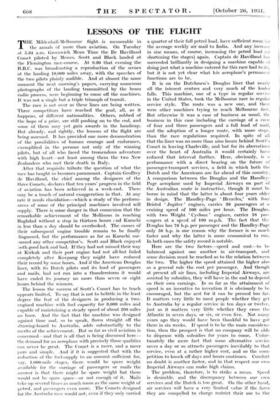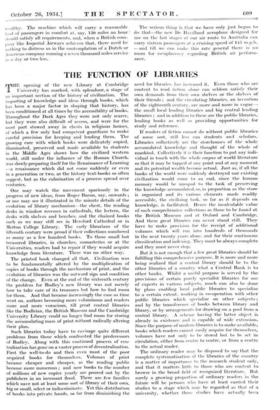LESSONS OF THE FLIGHT
THE Mildenhall-Melbourne flight is memorable in the annals of more than aviation. On Tuesday at 5.84 a.m. Greenwich Mean Time the De Havilland Comet piloted by Messrs. Scott and' Black . landed at the Flemington race-course. At 9.30 that evening the B.B.C. was broadcasting a reproduction of the scenes at the landing 10,000 miles away, with -the speeches of the two pilots plainly audible. And at almost the same moment the next morning's papers, carrying numerous photographs of the landing transmitted by the beam radio process, were beginning to come off the machines. It was not a single but a triple triumph-of transit.
The race is not over as these lines are being written. Three competitors have reached the goal, all, as it happens, of different nationalities. Others, robbed of the hope of a prize, are still pushing on to the end, and some of them may yet gain awards in the handicap. But already, and rightly, the lessons of the flight are- being assessed. It has provided one more demonstration of the possibilities of human courage_ and endurance, exemplified in the persons not only of the winning pilots, but of all who faced the tremendous adventure with high heart—not least among them the two New Zealanders who met their death in Italy.
After that requisite tribute the question of what the _ race has taught us becomes paramount. Captain Geoffrey de Havilland, the chief among the designers of the three Comets, declares that ten years' progress in the field of aviation has been achieved in a week-end. There may be a touch of natural exaggeration in that. At any rate it needs elucidation—which a study of the perform- ances of some of the principal machines involved will supply. There is some danger in that connexion that the remarkable achievement of the Mollisons in reaching Baghdad without a stop in thirteen hours nd Karachi in less than a day should be overlooked. The causes of their subsequent engine trouble remain to be finally diagnosed, but the performance as far as Karachi sur- passed any other competitor's. Scott and Black enjoyed 'both good luck and bad. If they had not missed their way at Kirkuk and their port engine had not all-but failed completely after Koepang they might have reduced their record by some hours. And if the American Douglas liner, with its Dutch pilots and its load of passengers and mails, had not run into a thunderstorm it would have ended its journey no more than seven or eight hours ,behind the winners.
The lesson the success of _Scott's Comet has to teach , appears limited, To say. that is not to belittle in the least degree the feat of the designers in producing a two engined machine with fuel capacity for 3,000 miles and capable of maintaining a steady speed of about 200 miles an hour. And the fact that the machine was designed against time and, so to speak, flown straight off the drawing-board to Australia, adds substantially to the merits of the achievement. But so far as civil aviation is concerned—and that is all that is being discussed here— the demand for an aeroplane with precisely those qualities can never be great. The Comet is a racer, and a racer pure and simple. And if it is suggested that with the reduction of the fuel-supply to an amount sufficient for, say, 1,000-mile stages, there would be spare weight available for the carriage of passengers or mails the answer is that there might be spare weight but there would not be spare space—or not enough of it. Mails take up several times as much room as the same weight of petrol, and .passengers even more. The Comets designed for the Australia race would not, even if they only carried a quarter of their full petrol load, have sufficient room for the average weekly air mail to India. And any increase in size means, of course, increasing the petrol load (or shortening the stages) again. Captain de Havilland has succeeded brilliantly in designing a machine capable of doing just what a machine entered for this race had to do, but it is not yet clear what his aeroplane's permanent functions are to be.
It is on the Dutchmen's Douglas liner that nearly all the interest centres and very much of the kudos falls. This machine, one of a type in regular service in the United States, took the Melbourne race in regular service style. The route . was a new one, and there were other machines trying to reach Melbourne first. But otherwise it was a case of business as usual, the business in this case including the carriage of a crew of four and three passengers and a full load of. mail, and the adoption of a longer route, with more stops, than the race regulations required. In spite of all that the liner was no more than nine hours behind Scott's Comet in leaving Charleville, and but for its aberrations over the heart of Australia it would certainly have reduced that interval further.. Here, obviously, is a performance with a direct bearing on the future of passenger-transport services, a field in which both the Dutch and the Americans are far ahead of this country. A comparison between the Douglas and the Handley- Page aeroplane used by Imperial Airways on part of the Australian route is instructive, though it must. be borne in mind that the latter is about four years older in design. The Handley-Page Heraeles,' with four, Bristol ' Jupiter engines, carries 38 passengers at a cruising speed of 100 miles per hour. The Douglas, with two Wright ' Cyclone ' engines, carries 18 pas- stingers at a speed of 190 m.p.h. The fact that the Douglas has 78 h.p. per passenger and the Handley-Page only 58 h.p. is one reason why the former is so much faster and why the latter is more economical to run. In both cases the safety record is notable.
Here are the two factors—speed and cost—to be balanced against one another in air-transport, and some decision must be reached as to the relation between the. two. The higher the speed attained the higher also as a general rule the cost per passenger. And though at present all air lines, including Imperial Airways, are assisted by subsidies, they will have in the end to depend , on their own earnings. In so far as the attainment of speed is an incentive. to invention it is obviously to be encouraged, but the zest for it can be pressed too far. It matters very little to most people whether they get . to Australia by a regular service in ten days or twelve, just as it matters very little whether they cross the Atlantic in seven days, or six, or even five. Not many . years ago they would have been thankful to have got_ there in six weeks. If speed is to be the main considera-. tion, then the prospect is that no company will he _able to dispense with subsidies for years to come. Unfor- tunately the mere fact that sonic alternative service saves a day or so attracts passengers.inevityabl to that service, even at a rather higher cost, and so the corm- petition to knock off days and hours continues. Comfort no doubt is another factor, and in that respect our own Imperial Airways can make high claims.
The problem, therefore, is to strike a mean. Speed. is desirable, and the discrepancy between our own. services and the Dutch is.too great. On the other hand, air services will have a very limited value if the .fares they are compelled to charge restrict_ -their use to the i%calthy. The machine which will carry a reasonable load of passengers in comfort at, say, 150 miles an hour should satisfy all requirements, and; when a British com- pany like Imperial Airways achieves that, there need be not ping to distress us in the contemplation of a Dutch or American company running a seven thousand miles service ill a day or two less. The serious thing is that we have only just begun to do that—the new De llavilland aeroplane designed for use on the last stages of our air route to Australia can carry sixteen passengers at a cruising speed of 145 m.p.h. —and till we can make this rate general there is no room for complacency regarding British air perform- ance.























































 Previous page
Previous page